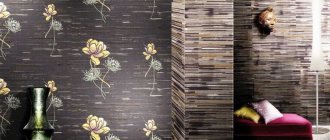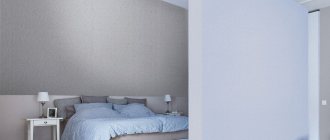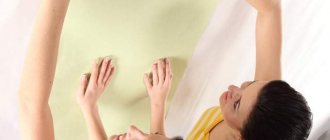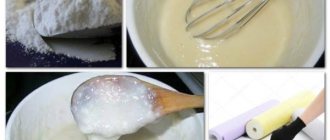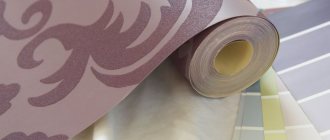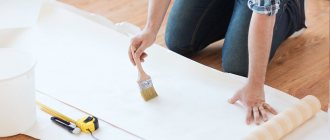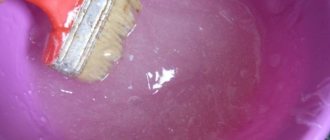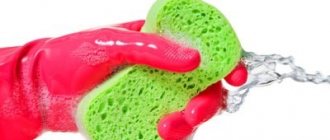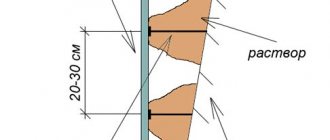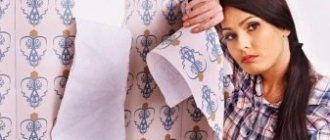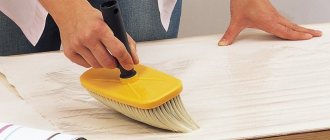Rollers
A roller is a small rotating device with a handle designed to level a surface or evenly apply glue, paint, varnish and other material over it. There are several types of tools that can be useful when gluing wallpaper.
Wallpaper
The wallpaper roller is designed to smooth out thin layers of paper that a spatula (wallpaper) cannot handle. During work, you just need to roll the tool along the front side of the material, thereby squeezing out the air from under the wallpaper. The rollers are classified by degree of hardness: yellow is the most delicate, black is the hardest. If the wallpaper has a relief (bulges), then it is best to use a soft roller - otherwise you risk pushing through the pattern. The black tool is useful for gluing wallpaper without relief.
For joints
Another type of wallpaper tool, which is also classified by color. Unlike the previous option, this roller is quite narrow, so it is convenient to use it to process the joints on the wallpaper. This procedure must be carried out so that several glued surfaces adhere better to each other. As with a regular roller, you need to select a tool of a certain rigidity for a specific type of wallpaper. If the roller is too hard, you risk ruining the pattern of the surface being pasted.
For corners
This wallpaper tool has an unusual shape - a cut cone. It is designed for longitudinal smoothing of corner surfaces on wallpaper. It is extremely important to carry out such work, since it is from the corners that in most cases the wallpaper begins to peel off. The corner bead ensures reliable fixation of the glued surface to the plaster. Unlike the two previous varieties, this tool is not classified by degree of hardness - the color of the roller in all cases will be white, and its hardness will be approximately the same.
Painter
A soft tool typically used to apply paint to a hard surface. In the case of wallpaper, a paint roller comes in handy to evenly distribute the construction adhesive over the inside of the paper material. We simply apply glue to the wallpaper in the amount recommended by a specialist, and then roll the substance over the entire area, not forgetting to thoroughly coat the edges. When choosing a roller, pay attention to the length of the pile - it should be medium.
List of all possible tools
When you make a list of the necessary materials and tools, take into account the fact that during the preparatory stage you may need not only tools associated with applying glue, etc., but also improvised means for tearing wallpaper off the walls (or removing old paint), and for filling various holes with putty.
First, let's list all the tools for gluing wallpaper:
- paint roller,
- wallpaper roller,
- wallpaper roller for corners,
- painting bath,
- bucket,
- sponge,
- drill,
- insulating tape,
- pencil,
- brush,
- ruler,
- stationery knife,
- scissors,
- screwdriver,
- plumb line,
- construction tape,
- construction mixer,
- rag,
- square,
- level,
- cord,
- painting spatula,
- wallpaper spatula,
- wallpaper brush,
Please note that this list of tools is not mandatory. So, you can apply glue to the wallpaper using one roller (not several). You can cut the canvas either only with scissors, or only with a stationery knife.
Paint roller
Wallpaper rollers come in different varieties. Let's look at painting first. When choosing a paint roller at a hardware store, ask the sales assistant to bring you a roller with medium-length bristles. This tool is used to apply diluted glue to the surface of the cut fabric or directly to the walls, depending on the type of wallpaper chosen.
Paint roller
Wallpaper roller
The purpose of this roller is not to apply an adhesive solution to the surface to be glued or rolls, but to smooth out the cut canvas that is already glued to the wall. Thus, thin wallpaper is not intended for use with a spatula, as it can damage it. This tool will come to the rescue and help you get rid of bubbles and excess glue between the wall and the canvas. Wallpaper roller comes in two colors – yellow and black. The first is used if your wallpaper has a raised pattern and you don’t want to “crush” it, and the second is used for a more even surface when there is no fear of ruining anything.
Wallpaper roller
Wallpaper roller for corners
Thanks to its conical shape, it will allow you to apply the necessary pressure on individual areas of the canvas - namely in the corners.
Wallpaper roller for joints
Painting bath
After you dilute the glue in a randomly selected container, you should choose a good tray that will allow you to distribute the glue evenly over the entire working area of the roller. The bath consists of two parts - there is a flat surface and there is a smooth surface. The roller needs to be rolled precisely on an uneven surface with ribs. The size of the paint bath directly depends on the size of the roller (its width should be slightly larger than the width of the roller).
Painting bath
Bucket
You will need a bucket to dilute the glue solution in. At the same time, if you expect to use glue the next day, then it is best to choose a bucket (or any other container) with a tightly closed lid. This is the only way to store glue! Of course, do not forget to place the container in a cool place, out of reach of sunlight. If you are interested in the question of how to glue wallpaper, then we suggest that you read another article on our website.
You can’t do without a bucket, you need it for stirring the glue
Sponge
It will be useful for wiping off excess glue along the edges of the canvas glued to the wall. Choose a sponge that is as soft as possible, and if its side has a more ribbed surface, then do not even think about wiping your wallpaper with it, as you can easily damage it.
A sponge is useful in the process of wallpapering
Drill
This tool can come in handy if you don't have a construction mixer. Select a nozzle so that you can stir the glue solution.
A drill is convenient for stirring glue
Insulating tape
It is quite natural to have at least one switch and one socket in any room. After you unscrew them and take out the boxes, you should be sure to insulate all the wires, otherwise you will expose yourself to danger. And electrical tape will help you with this.
Fabric tape
Pencil
You will need a pencil to mark the walls. Choose a pencil that will be visible on the concrete wall. Thus, construction stores offer everyone who wants to buy a construction pencil.
Buy a good pencil before wallpapering
Brush
Here we will not consider each brush option in detail. They differ in width, elasticity of the fibers (soft or harder) and their length. If you do not use rollers, which, if you have already understood, can have different purposes (for canvases, for corners and for joints), then be sure to buy one wide and one narrow brush. A wide brush will help apply a layer of glue to the canvas or the surface of the wall, and with a narrow brush you can coat the walls at the joints and corners between the wall - ceiling and wall - floor.
Wallpaper brush
Ruler
If you don’t have a construction tape at home (like any other), you’ll have to use what you have. A ruler will help you measure the height of your walls and determine the length of the wallpaper. Do not forget that you need to add about 5 cm to the resulting wall height for adjusting the canvases to each other.
The most common ruler
Stationery knife
You will need a utility knife to cut the canvas to the specified length. It is very convenient if you want to trim corners. A knife is also used to trim the fabric along the baseboard or ceiling. In addition, during the process of wallpapering walls, bubbles may appear under the canvas, which cannot be removed with a roller or spatula. In this case, you can try to make a small cut in the wallpaper. True, it is best to use a thin needle for these purposes. It is better to make 3-5 small holes with a needle and spend a little more time than one large and conspicuous “hole”.
Stationery knife
By the way, if the knife blade becomes dull, do not rush to buy a new one. Drive the blade inside the knife so that one part remains outside (until the last notch). Take a pair of pliers and break off a piece. So, you can use a new sharp blade on the edge of the knife. In addition, you can protect yourself from unnecessary injuries by hiding your eyes under construction glasses.
Scissors
They will be suitable for you to cut the canvas to the desired size. But, unlike the same stationery knife, it seems to us that cutting off the corners, and even more sharply a thin line under the ceiling, will be much more difficult and inconvenient with scissors.
Scissors are an important tool in wallpapering.
Screwdriver
A screwdriver is useful for removing boxes from sockets and switches. Do not forget to insulate the wires after this, as described above.
There is a screwdriver in every home, and it comes in handy
Plumb
A very necessary tool, because how smoothly you glue the canvas to the wall depends on its availability and proper use. Attach the top to the top so that the weight “dangles” at the bottom. Now draw a straight line along the hanging thread with a pencil or felt-tip pen. A plumb line allows you to apply even vertical markings.
The plumb line is also useful for wallpapering.
Construction tape
I think there is nothing to explain here - a tape measure will help you measure the height of the walls, their width, and also cut out the wallpaper correctly.
Construction tape
Construction mixer
The mixer is designed for stirring the adhesive solution. If you don't have a construction mixer, don't despair! In any case, even if you use a clean wooden stick, this process will not affect the properties of your glue for the worse. You just have to devote a little more time and effort to the stage of bringing the glue to the desired concentration, plus you will have to add the dry mixture in smaller portions than using a mixer. But if you are the happy owner of this tool, then pick up a construction mixer, turn on low speed and gradually pour out Place glue in small portions into a bucket of cool water (hot water is not recommended).
Construction mixer
Rag
Using a rag soaked in water (be careful: it should be wet, but not to the point that water drips from it), wipe the surface of the glued canvas, getting rid of excess stains and stains. It is best that it is soft - it will not damage the wallpaper.
The most common rag
Square
The tool will be useful to you if you need to cut out various geometric shapes from a roll of wallpaper. Use a square to draw a right angle.
Square
Level
A level is required in order to stick the canvas in a straight, vertical position. A level and plumb line are important tools for wallpaper work!
Level
Cord
You can make a plumb line out of it by attaching a small weight. On the other hand, the cord can be used to mark walls horizontally.
Even a simple lace can help you
Painting spatula
To cut wallpaper near the ceiling or floor, place a spatula there and draw a straight line with a utility knife.
Painting spatula
Wallpaper spatula
The working surface of such a spatula is not metal, but plastic or rubber. The fact is that it is necessary to smooth the canvas on the wall, which will allow you to expel excess glue and bubbles. Plastic and rubber will not damage your wallpaper. But remember that if your wallpaper is very thin, a wallpaper roller will be the best choice for this stage of pasting.
Wallpaper spatula
Wallpaper brush
If you don’t have a roller or brush, you can use a brush to apply glue to the canvas or wall surface. But its main purpose is the same smoothing of the canvas glued to the wall. The brush is especially convenient when used when gluing not walls, but the ceiling.
Wallpaper brush
Painting bath
A paint bath is necessary to evenly distribute the varnish or wallpaper glue. The mass that needs to be used for application to the roller will be on the ribbed surface, and the excess will accumulate at the bottom of the tray. It is extremely important to choose a container that matches the size of the roller, otherwise you risk encountering problems when working with glue. After the ribbed surface is perfectly clean, you need to slightly moisten the roller in excess and begin rolling it again in a specially designated area.
Soft rags
A rag is a special cleaning material that is used to remove various contaminants in the form of oils, paint or dust, as well as to straighten the surface for painting. When working with wallpaper, a cotton cloth is useful for removing excess glue. If you accidentally apply too much adhesive material to the wallpaper, simply run a rag over it several times, which will absorb all the glue like a sponge will absorb water. Try to purchase this material with a reserve - it costs a penny, but brings invaluable benefits.
Wallpapering technology for walls
There are certain rules for gluing canvases. But first they need to be measured and cut correctly. If the wallpaper does not have a specific pattern and adjustment is not needed, only measure the height and cut off the required length of the sheet. To ensure that the cut is even and strictly at 90°, a mark is placed on the canvas and the strip is bent so that the side cuts are parallel. Then a strip is cut along the fold.
If it is necessary to join the pattern, first cut off one strip, then apply the canvas to it so that the pattern matches. In this case, the consumption of wallpaper will be greater. If, with a standard wall height of 2.4 m, 4 stripes come out of one roll, in which there is no need to select a pattern, then if the ornament is observed, only 3 stripes will be obtained.
Where in the room do you start wallpapering?
The strips are glued one after another, starting from the window. This rule must be followed so that the joints remain invisible. This is especially worth considering when the wallpaper is glued overlapping. If the stripes are placed end-to-end, you don’t have to adhere to this rule, but use another option.
Usually, wallpapering with your own hands starts from a window, corner or door. The vertical marking will be from the place where the furniture will be placed. Since there may be a small gap between the first and last sheet, the discrepancy in the design will be too visible.
Technique for applying glue and gluing canvases on flat areas
The main condition when working with wallpaper is that windows and doors are closed; drafts must not be allowed to appear. The second rule is to read the instructions on how to properly glue wallpaper. It comes with the rolls. The technique for applying the adhesive and gluing the canvases is different for different types of trellises. The instructions provide a graphic description of the material and how to work with it. And in the instructions for the glue you will find a description of how and in what proportions to dilute.
How to glue the first strip:
- Lay the roll out on a flat surface, preferably on the floor, and cut to the required length.
- Apply glue to half the strip and brush the edges.
- Then fold the half of the coated fabric in half without pressing on the fold.
- The same must be done with the second half.
- The impregnation time is indicated on the instructions supplied with the wallpaper; a thin single-layer material is impregnated in 1-2 minutes, a denser one in 5-7 minutes, for vinyl canvases it will take 10 minutes. If the wallpaper is non-woven, glue is applied only to the wall.
- While the canvas is soaking, it is necessary to lubricate the wall with glue; the adhesive composition is applied slightly wider than the width of the strip.
- Straighten the top part of the sheet, leave the bottom tucked in and attach the top cut to the wall, aligning it with the vertical markings.
- Lightly press the top of the strip and then straighten the rest.
- To glue the strip, use a spatula, following the movement pattern: from the middle to the edges and from top to bottom. All bubbles must be removed with smooth guiding movements.
- Excess material is cut off with a utility knife. To make an even cut, make a fold or go over the cut area with a spatula.
- Next, move on to gluing the next strip.
Single-layer paper wallpapers are glued overlapping, dense wallpapers are glued end-to-end. Go over the joints of the strips with a small rubber joint roller, and remove excess glue with a soft rag or sponge.
Technique for gluing wallpaper in corners
There are no absolutely even corners, so it’s not easy to stick wallpaper in these places. Due to the curvature, distortions and tension are obtained. Therefore, the canvas is pre-cut into two strips.
The first one is glued, going 1-2 cm around the corner, the second one is overlapped. If the wallpaper is too thick, press the double strip with a spatula and draw it into the corner with a knife, cutting two strips at once. The top and bottom trims are removed, and the edges are pressed with a staple or roller.
The technique for gluing external corners is no different. When gluing one canvas, it is brought around the corner, the second - overlapping. Then apply a ruler to the corner and draw it with a knife, cutting off the edges from the strips. The trimmings are removed and the sections are glued to the corner. Go along the seam with a roller.
The nuances of gluing wallpaper near windows, doors and behind radiators
If you are gluing wallpaper in a circle and have reached the door or window, the excess wallpaper is simply cut off. But this must be done carefully. For this:
- press the canvas to the trim or frame;
- make a cut diagonally to the corner of the casing;
- wrap the material to be cut along the opening;
- cut off the excess fabric from the top and sides with a knife;
- Use a knife to place the cut under the frame or trim.
How to glue wallpaper to window slopes:
- if the material is thin, the strip is glued with a bend onto the vertical slope;
- in the upper corner of the slope, the canvas is pressed tightly and cut with a knife;
- cut out and glue the top strip of the slope, taking into account the upward bend of 1 cm onto the wall.
If you are working with non-woven wallpaper, these overlaps will be visible, so they will need to be cut exactly along the window opening.
It is extremely difficult to carefully glue wallpaper behind the battery without removing it. To do this, you need to take all measurements and cut a strip of the required width and height. On the pattern, mark the places where the radiator is attached and make straight vertical cuts. The canvas is smeared with glue, allowed to soak, and then placed behind the radiator and pressed. Folds are straightened with a soft cloth.
How to perfectly match wallpaper
It is not easy to ensure that the joints between the strips are invisible. Maximum care is required here. It must be remembered that wet sheets stretch well, but when dry they shrink and a small gap may form. The strips are glued close to each other without overlapping, but when gluing, you should not stretch the wallpaper too much. If after drying a small seam or base of the wallpaper is still visible, this defect can be hidden with a corrector.
If, when gluing the strips, the seam turns out to be quite noticeable and cannot be stretched in any way, do not be afraid to remove the strip and glue it again, moving it slightly in the desired direction. The convex seam can be removed if you go over it with a special roller.
If you glued the strips overlapping and the seam turned out to be too voluminous, you can eliminate this defect as follows. Let the canvases dry a little, but not completely. Then place a long ruler along the seam and use a utility knife to cut off both layers. The knife should be as sharp as possible so that the cut is smooth and neat. The trimmings are removed.
Carpenter's pencil
A carpenter's pencil is necessary for marking the wallpaper for further cutting. Of course, a regular stationery tool may also be suitable for this purpose, but a paint pencil has greater hardness and produces straight lines even on a wet surface. But under no circumstances use felt-tip pens or ink pens as an alternative. Such tools apply the markings too deeply under the layer of paper, as a result of which it can begin to show through on the front side of the wallpaper.
Gluing wallpaper
First of all, prepare a place where you will measure, cut and apply wallpaper with glue. This could be a clean section of the floor or a piece of oilcloth spread on the floor. Prepare your tools so that they are always at hand. Dissolve the glue according to the instructions. Place a stepladder. And begin.
- Unwind the roll and measure the fabric to the required length. Cut it with sharp scissors or a special sharp knife. Cut the wallpaper strictly horizontally, using a metal ruler for this. To avoid damaging the floor, place a large cutting board under the wallpaper where the cut is made.
- Carefully read the instructions that come with each roll. Some wallpapers require applying glue to the canvas, some to the surface of the wall, some to both the wall and the canvas. Spread the canvas on the floor or oilcloth and apply glue to it (if you are gluing paper or vinyl wallpaper)
- Let the wallpaper absorb the glue a little. Five to seven minutes will be enough. After this, carefully lift the wallpaper by the top edge and begin gluing
- Start gluing from the window. A window or other opening will be an excellent vertical reference. To align the wallpaper vertically, use a level. It is enough to level the first canvas, and glue the next ones, focusing on it
All types of wallpaper are always glued with the windows and doors closed. The room should be warm, about 20°C. Draft is the first enemy of fresh wallpaper. The glue dries very quickly in a draft, and in some places the wallpaper simply does not have time to stick.
- Carefully lift the canvas to the ceiling and glue it to the wall, pressing well. Carefully bring each subsequent canvas to the previous one (end-to-end or with a slight overlap, if the type of wallpaper allows it) and smooth it out. To smooth, use a soft spatula or a large dry cloth. Smooth from the middle of the canvas to its edges
- If air bubbles appear under the wallpaper, they need to be smoothed out by squeezing the air over the edges of the canvas. This must be done very carefully so as not to damage the wallpaper. If the air bubble cannot be squeezed out or there is a risk of tearing the wallpaper, pierce it with a needle and gently squeeze out the air
- Cover the corners with two sheets, connecting them slightly overlapping. If you paste a corner with one sheet, then with a high degree of probability folds will form in this corner or the wallpaper will completely fall away from the corner after drying.
- What to do with sockets and switches? First, turn off the electricity. Remove covers from all outlets and switches. After the canvas is pasted, carefully make a cross-shaped cut in the wallpaper at the place of the rosette. Bend the resulting corners and cut off the excess with sharp scissors.
After you have dealt with the sticking, close the room and try not to use it for at least a day. Under no circumstances open the windows or create drafts, otherwise after a short time your new wallpaper will peel off the wall with a nasty crunch.
Paint brush
A paint brush is used to evenly apply wallpaper glue in the most inaccessible places where a roller cannot reach - corners, joints between a wall and a floor or a wall and a ceiling. This tool is also often called a “Fleitz brush” - keep this in mind when choosing it in the store. The paint brush consists of a wooden handle with a metal frame, as well as pile bristles. However, if you have dealt with painting work, then this device should be familiar to you. The optimal width of the brush is 4-6 centimeters.
Preparing the room for wallpaper
When starting to decorate the walls with wallpaper, you first need to clear the room of unnecessary objects: take out the furniture, clear the walls of paintings (if any). So now you can bring the rolls into the room.
Preparing walls for wallpapering
Quite an important stage. It is necessary to thoroughly clean the walls from the previous layer of decorative coating.
When removing old wall coverings, the following problems may occur:
- if it is impossible to remove old wallpaper from the wall, then you can use alkyd primer paint, after diluting it with white spirit in a ratio of 1:3;
- In some cases, it can be very difficult to remove dirt, oil and grease stains, as well as fungal infections from surfaces: this problem can be solved by rubbing with a dry, lint-free cloth soaked in acetone or pure gasoline.
Particular attention should be paid to the presence of cracks on the wall. If they are present, they should be primed with gypsum or cement mortar. For more thorough bonding to the wall, existing defects must be moistened with water and then the prepared mixture must be applied.
When preparing walls for wallpapering, you should putty the surface, then prime the completely dry walls. The better and smoother the putty, the fewer problems there will be when gluing wallpaper.
The final result will depend on the correct preparation of the walls. After all, if the walls are poorly cleaned of old decor and the cracks are not sealed, then all this will be reflected in the wallpaper.
Glue selection
The appearance of the wallpapered wall depends on this stage. After all, even expensive wallpaper will be ruined by the appearance of unadhered joints. To prevent this from happening, you need to choose the right glue. Types of wallpaper glue:
- in liquid form, which does not require additional preparation and is already ready for the process;
- powder or granular adhesive composition. This type of glue requires preliminary preparation; it should be diluted according to the instructions written on the package.
The first type of glue is mainly necessary for additional gluing of joints between wallpaper; it is very convenient for gluing hard-to-reach places. This glue is also used for ceiling borders.
In construction supply stores, depending on the wallpaper covering, you can find the following types of dry wallpaper glue:
- universal glue - this type of glue requires diluting it with water: as a rule, it is prepared taking into account the choice of coating - if it is heavy wallpaper, then the consistency of the glue should be thicker, and if the wallpaper is paper, then it should be more liquid;
- adhesive for vinyl wallpaper - designed specifically for this type of coating;
- for non-woven wallpaper - this adhesive can be used for vinyl coverings based on non-woven material;
- adhesive for textile coverings;
- glue for velor wallpaper;
- for glass wallpaper.
Of course, first of all, before diluting the dry glue mixture with water, you need to read the instructions on the package and follow them, taking into account the type of wallpaper chosen. The main rule to remember is that dilution is carried out by adding the dry mixture to water, and not vice versa. In this case, the solution must be mixed with a construction mixer or simply with a long stick. The solution is considered ready when there are no lumps in the resulting mixture. On modern store shelves you can also find glue with an indicator. This type is very convenient, as its pale pink color helps you see where the adhesive solution is applied and where you should go over it again with a brush or roller.
Ruler
Using a pencil without a ruler is almost pointless, since you won't be able to draw straight lines with it. A long metal ruler, suitable for construction and repair work, will help you cope with this task. Alternatively, you can use a plastic or wooden tool, but be aware that the corners on these tools tend to break, especially with regular use. In addition, a metal ruler is ideal for working in tandem with a stationery knife - there is no chance of curvature appearing on the cuts.
Construction mixer
This tool is used to create a uniform adhesive mass by mixing wallpaper paste with water. Instead, many builders use a regular wooden stick, but it does not give the same quality result as an electrical device. Just a few minutes of using the mixer is enough for the mixture to be ready - and no lumps inside! The most important thing is to take your time and work at minimum speed, gradually pouring glue into the water in small portions (it is not recommended to pour out all the powder at once).
Stationery knife
A regular utility knife is best suited for cutting wallpaper, as well as trimming the bottom and top edges of baseboards. Unlike a kitchen or hunting knife, a stationery knife has one significant advantage - the thickness of the blade is no more than 2 mm. Thanks to this, the cuts are perfectly straight. If the blade becomes dull, it is enough to break off its lower tip (there are notches every centimeter). When choosing a knife, try to give preference to Russian or European tools, since Chinese models are not of the best quality.
Scissors
Where a stationery knife cannot cope, ordinary scissors designed for working with cardboard will help. It is especially convenient to use this tool to create holes for sockets, switches, gas pipes and other geometric shapes that cannot be cut with a knife. The main requirement for the tool is the sharpness of the blade. It is unlikely that the work can be done efficiently if you use old, dull scissors. So before wallpapering, don’t skimp on setting aside 100 rubles to purchase new scissors.
Tools for wallpapering: how to choose, where to stop
One of the most labor-intensive and difficult moments in any repair is wallpapering.
It’s not for nothing that they say that if you want to bring your family life to the point of divorce, glue the wallpaper together. It seems that there is nothing complicated in this matter: cut pieces of paper, spread glue, and stick them on. But as soon as you start doing the work, problems begin that you didn’t expect. All of them arise from inexperience - this is understandable; if you are not a professional interior decorator, then where do you get the skills and abilities. Most often, many people who start renovations follow the simplest path - they hire specialists who will do everything for them. But there are also pitfalls here: firstly, it’s a waste of money, and secondly, there is no guarantee that after such masters, in a week or two everything won’t fall off the walls in layers and then “put out the lights.” And this happens, unfortunately, very often. Therefore, it would be most correct to master the technique of wallpapering yourself and do everything without the involvement of strangers. It’s not as complicated as you thought at the very beginning of reading our article. Below we will analyze in detail all aspects of the “wallpaper craft”, tell you what tools you need to have on hand and how to use them correctly. After which, you can safely begin to test your acquired knowledge in practice and, as a result, rejoice at a well-done repair.
Plumb
A very important tool for wallpapering. It is a small metal weight with a long thread attached to the top. When wallpapering, the plumb line is suspended from the ceiling using tape. Due to the fact that the thread is stretched under the weight of the weight, the line is perfectly straight to serve as a guide. Many novice builders neglect the possibility of using such a device, as a result of which the wallpapering turns out to be uneven.
After the wallpaper was hung...
When all the work is completed, do not forget to immediately wash all the tools thoroughly and remove any glue residue. In this case, they will serve you for a very, very long time.
You will have to wash everything from the ruler to the rollers and brushes. Usually, any wallpaper glue, until it dries, can be easily washed with ordinary warm water; if necessary, you can use any dishwashing detergent. Clean thoroughly, rinse until all instruments are clean. If you miss the moment and the glue has dried, then soak everything in warm water for several hours, then also wash them in running water. But, of course, it’s better not to let it come to this, then you won’t need to buy a new tool for the next repair, you will already have a completely ready-made kit for gluing wallpaper.
When gluing wallpaper, take your time, do everything carefully and carefully. If the wallpaper has a pattern, carefully combine it and try to make everything look like one solid piece, without visible seams. Don't think that you are working slowly - you are not chasing time records in sticking. Carefully remove all bubbles; if one turns out to be too persistent, then carefully pierce it with a needle or cut it slightly with the tip of a knife and smooth it out. Bubbles not only look completely unsightly, but also lead to rapid peeling of the wallpaper. Please note that you cannot glue wallpaper in a draft.
The article was prepared by master Roman for clients of the store Levsha.rf
Roulette
A construction tape is an almost ideal tool for taking measurements on any plane. Considering that when working with wallpaper you have to constantly measure the width or length of the walls, as well as apply even stripes to the wallpaper, a tape measure will prove to be an indispensable tool. There are no special requirements for the device. The main thing is that the tape measure is long enough to measure walls and wallpaper. If you want to buy a tool that will last for several years, give preference to branded models.
The nuances of working with different types of wallpaper
If you've ever had to glue wallpaper, you've probably noticed that the wallpaper "behaves" differently every time. It's all about the quality of the canvas. This affects the final price, so you should choose wallpaper for the type of renovation. How much an elite apartment renovation or cosmetic renovation costs depends on the type of wallpaper in particular.
How to glue paper wallpaper
The paper type of materials includes thin single-layer simplex and multilayer duplex. The first one will quickly get wet if you hesitate, and can creep apart. Therefore, it is allowed to soak in glue for no more than 1-2 minutes. Glue it only with an overlap.
Duplex is easier to work with. It is smeared with glue and allowed to soak for 5-7 minutes. Canvases are glued only end to end.
Vinyl wallpapering
When working with this material, the type of substrate is taken into account and rolls are produced on a paper or non-woven base.
Vinyl sheets on a paper base are glued in the same way as paper wallpaper, the gluing technique of which we discussed above. You can find out which adhesive to choose for this type of wallpaper by reading the insert instructions.
If you choose non-woven vinyl wallpaper, the gluing technology will be different. The canvases are not impregnated with glue, since they have sufficient plasticity and sufficient weight. The adhesive composition is applied only to the wall and the strips are immediately glued to it, joining them one to one without overlapping.
Technique for gluing non-woven wallpaper
For this type of material, choose glue marked “for non-woven fabric”. The peculiarity of this glue is in its characteristics, since it is applied only to the wall, but not to the wallpaper. This glue is intended for non-woven fabrics. Wallpaper of this type is produced mainly in meter widths. Since the strips are quite heavy, it is extremely difficult for one person to hold and straighten them, so it is best to glue them together.
How to glue photo wallpaper
The technique for gluing photo wallpaper depends on the quality of the material. They are produced on paper or non-woven basis. Before starting work, you need to decide on the location of the decor. Photo wallpaper can be in the form of stripes or in the form of rectangles, so it is important to make appropriate vertical and horizontal markings. All fragments are glued end to end. If there is a white edge on the strip, it must be cut off.
It is important that the walls are thoroughly cleaned; there should be no bumps, scratches or chips on them. On smooth glossy wallpaper these defects will be very visible. Such defects can only be hidden with thick, embossed photo wallpaper. If the photo wallpaper is non-woven, it can be glued to other wallpaper, but the base should not peel off.
Is it possible to glue wallpaper onto wallpaper?
This wallpapering technique is used extremely rarely. But if the previous wall decoration was done with high quality, this option can be used.
The technique for gluing wallpaper onto wallpaper is as follows:
- Before gluing a new layer, you need to check all the joints on the old coating and, if necessary, glue the places where there are errors.
- Apply primer or glue to the old substrate.
- Apply glue to the new canvas.
- Glue the strip.
- Level with a spatula.
Square
A convenient device designed for constructing perpendicular angles. When working with wallpaper, a square will be especially useful for cutting out various geometric shapes with 90-degree angles. For example, with its help you can quickly and evenly cut the angle for slopes on windows. Also, the square has its own marking at 30-40 centimeters, so it can be used as an alternative to an iron ruler. In the future, such a tool will be useful for any construction work.
Learn more about wallpapering tools
The list of tools above may seem overwhelming to many, but it is not. Let's talk in more detail about why each of them is needed.
Using a pencil, we will apply the marks we need on the wall and wallpaper. It is better to use a regular one with a soft lead so that the marks are clearly visible. Well, whoever wants can buy a special construction pencil.
Tape measure - it is used to measure the length of the wallpaper, take measurements of width, depth, height, it is very convenient to work with if there is a lock, and it is quite rigid. If possible, replace it with a laser rangefinder - the error will be lower and the work will become even easier.
A regular ruler will help with small measurements and the need to cut off small parts of the material.
Without a construction bubble level, it is unlikely that you will be able to glue the wallpaper exactly along a vertical line. For the same thing, you can use a plumb line or a laser level, if anyone has such a wonderful device on the farm.
A stationery knife or linoleum knife is a very convenient tool with replaceable blades - in principle, irreplaceable in the household. With its help, you can cut wallpaper from a single roll to the required length, and also trim it from the bottom after gluing, and trim it in the right places. Just don’t forget that the blade becomes dull on paper extremely quickly, so you need to remember to replace it - it’s done very simply: break off the dull piece at risk and you’ll have a sharp knife in your hand again.
In addition to a knife, you also need scissors; with their help, you can cut off small pieces of wallpaper, cut off some unnecessary parts around the same sockets and switches.
A paint roller will help apply glue to the wallpaper; it should not be very fluffy - it is better to use medium-length pile. It can be replaced with a wide brush with medium-hard bristles or a brush.
Wallpaper roller - it only comes in a smooth version; it can be used to easily straighten a sheet of wallpaper pasted on the wall and remove all air bubbles. When purchasing, you should take into account that wallpaper rollers are made in color for a reason: yellow is suitable for textured material, and a dark-colored roller is suitable for smooth material. There is a separate type of tool - a roller for corners, which has a cone shape. With its help it is very easy and simple to remove all the unevenness in the corners of the room when wallpapering.
A sponge with a soft surface will help remove glue drips and will do it carefully without damaging the paper. It can also be replaced with a damp and soft cloth – rags. In general, you need to have both on hand: very often glue drips from the front side of the wallpaper, it can be removed with a damp cloth.
Brushes for coating corners and difficult places: when gluing wallpaper in any room there are difficult places, they also need to be coated with glue in any case, otherwise that’s where everything will fall off in the end. Buy a brush that is narrow and wide – both will come in handy. Their pile should be thick.
The wallpaper spatula will be either plastic or made of rubber. They can and should also level the wallpaper. It is useful in places where a roller cannot reach, and for many people it is simply more convenient to work with them.
Brush – keep it on hand, it will replace a roller, brush, and will help apply glue to the wallpaper and/or wall.
A small or medium-sized sharp paint spatula - used to trim wallpaper in the ceiling area along the slab - is much more convenient than all other tools for this purpose. Please note that there should be no traces of plaster or glue on it - the blade must be completely clean. Simply place a spatula on the joint and drag it firmly across the paper.
A paint bath will help remove excess glue from a brush or roller. Its size should be larger than that of your glue application tool: just roll the roller along the grooved surface, pressing it against the tray. This will distribute the composition over the roller and allow you to remove its excess.
Level
The building level is a multifunctional tool that will be of great benefit when hanging wallpaper. The principle of its operation is the presence of several reservoirs of liquid, in which there is a small gas bubble. If the level is on a flat plane, the bubble occupies a central position. Thus, with the help of the tool, you can check whether the walls are even, and also draw perfect straight lines even without using a ruler. In addition, the level can serve as a guide when gluing wallpaper (similar to a plumb line).
Wallpaper brush
A wallpaper brush is a special type of construction tool designed to smooth the paper surface when gluing. It will be most useful when working with the ceiling part of the wallpaper. When purchasing, try to find a tool with short but hard bristles - such a device smoothes the surface best without damaging it. You can also use a wallpaper brush instead of a paint roller - use it to apply glue to the paper surface.
Wallpapering the ceiling
You can paste over not only the walls, but also the ceiling. The technology is the same as for gluing vertical surfaces. The base must be cleaned of the old coating, puttied and primed.
Before starting work, markings should be applied to the ceiling. The most convenient way to do this is with a dye cord. Tapestries are glued to the ceiling in two directions: parallel to the flow of daylight or perpendicular to the window. In the first option, the strips begin to be glued from the wall, moving parallel to the window. In the second case - from the center of the ceiling. Determine the center point of the ceiling and set it aside on both sides along half the width of the canvas. The guide lines must be strictly perpendicular and parallel to the walls. The technique for gluing rolls on the ceiling is the same as on the walls.
Painting spatula
A convenient tool for trimming wallpaper at the junctions of a wall with a ceiling or floor - just apply a spatula and use a utility knife. The width of the tool can be different, but the larger it is, the more convenient it will be to work - you won’t have to move the spatula from place to place and cut off one piece in several steps. However, choose a paint spatula, since a comb tool, designed to evenly distribute the solution over the tiles or tiles, is not suitable. It is not recommended to use a plastic spatula - it will quickly get damaged.
Wallpaper spatula
A special pressing tool designed to smooth the surface being pasted - ideally expels air bubbles and excess glue from under the wallpaper. Unlike a roller, a wallpaper spatula is good because it is suitable for working with any type of wallpaper. Also included with such a device is an instruction manual, which describes in detail exactly how to work with it. Of course, it is not necessary to buy a wallpaper spatula if you have a yellow roller, but it is still better suited for wallpapering.
Helpful advice: to avoid staining parquet or linoleum with wallpaper glue, spread several old newspapers, magazines and other waste paper on the floor. Even if you accidentally drop wallpaper glue onto the floor, the paper will quickly absorb it.
Wallpapering is a responsible procedure that requires a thorough approach. Even if you have done this task several times, if you do not have the necessary equipment, the result may not be the best. So try to get as many tools from the list as possible, especially if you plan to renovate the entire house. Impeccable work to you!
All about wallpapering
There are no unimportant moments in repairs that can be ignored or done carelessly. If you want the wallpaper on the walls to be perfectly hung, and the designer renovation of your apartments to be completed 100%, then you need to complete every point.
What tools will you need?
To hang wallpaper you need to prepare the following tools:
- measuring tape;
- tape measure, its length should be greater than the height of the walls;
- pencil;
- a ruler more than 50 cm long, preferably 70-100 cm, you can take a folding ruler;
- cutting scissors;
- stationery knife with blade;
- plumb line for marking the gluing of the first sheet.
These tools are necessary to measure and cut the required length of the canvas, set a mark for placing the first strip.
For gluing you will need:
- pressing spatula;
- roller for wallpaper seams;
- roller for applying adhesive to the wall;
- pressure-type rubber roller (required for rolling wallpaper);
- brush for primer and wallpaper paste;
- paint spatula for removing old plaster or wallpaper;
- rags, soft rags for removing glue from the surface of the canvas and excess from the seams.
You also need to take a bucket for diluting the glue, prepare a table or any other flat surface on which to cut the canvases and apply the adhesive composition to them.
What materials are needed
First of all, you need to buy the wallpaper itself. On sale there are non-woven rolls, vinyl, paper, liquid and glass wallpaper. They are chosen depending on the room in which renovation is planned. For the bedroom and nursery, it is better to buy eco-friendly wallpaper based on non-woven fabric or paper; for the kitchen, choose washable ones.
Before gluing wallpaper with your own hands, you need to prepare the walls. You will need to buy putty to seal cracks and a primer, which will ensure better adhesion of the canvas to the base. Applying a primer coat to the wall will also help reduce the amount of adhesive. If there is a mold problem in your home, it is recommended to use a primer with additional anti-mold ingredients. On sale: ready-to-use primer, also in the form of a concentrate or dry, which needs to be diluted with water.
Depending on the quality of the wallpaper, wallpaper glue is chosen. This is an important point! The quality of the glue determines whether the canvas will stick to the wall. You can always find information on the rolls about which glue is suitable. The same can be found on glue packages.
